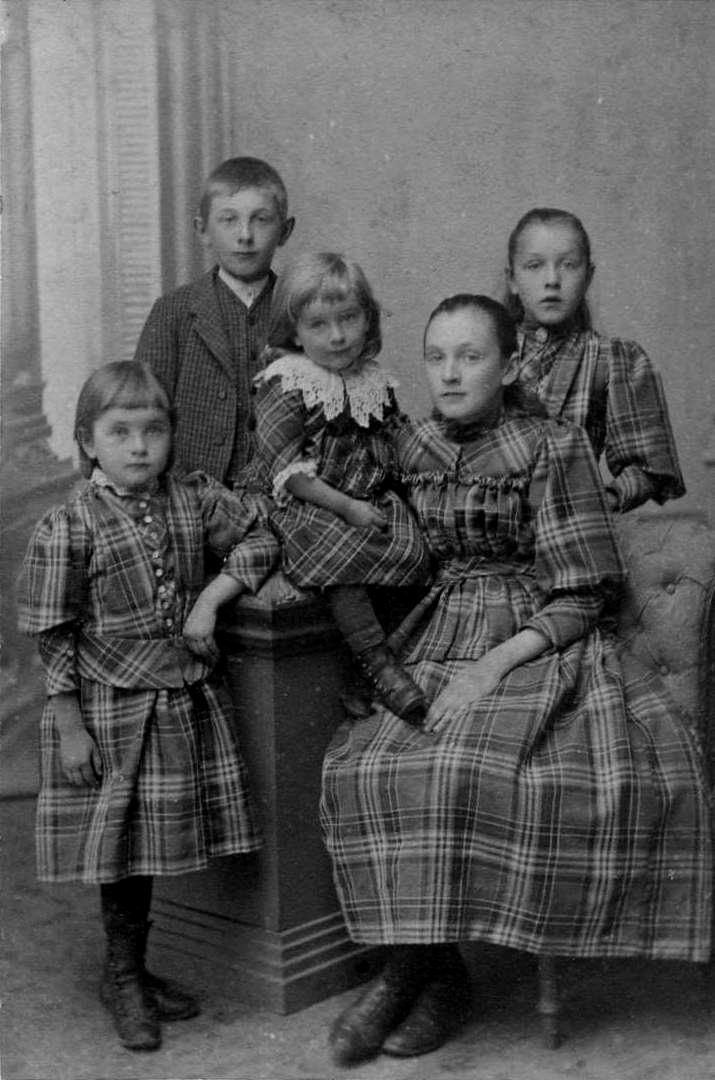
Unidentified Norwegian Family (1890s)

Figure 1.-- Here we have a CDV portrait of an unidentified Norwegian family. The portrait is undated. We would guess it was taken in the 1890s. At this time, Norway was still part of Sweden. Here the dress styles are a useful indicator. There are five children, four girls and a boy about 3-15 years of age. The girls all wear dresses mother must have made from the same plaid fabric, but in different styles. We are not sure about the color of the dresses, but one might guess that red was the dominant color.
|
|
Here we have a CDV portrait of an unidentified Norwegian family. CDVs continued popular in Europe after they were non longr common in America. The portrait is undated. We would guess it was taken in the 1890s. At this time, Norway was still part of Sweden. Here the dress styles are a useful indicator. There are five children, four girls and a boy about 3-15 years of age. The girls all wear dresses mother must have made from the same plaid fabric, but in different styles. We are not sure about the color of the dresses, but one might guess that red was the dominant color. The boy wears a patterned vested suit with a short that does not seem to have a collar. Rather it sems to be a kind if shirt waist that just buttined at the collar. All the children seem to be wearing long stockings. They seem to be different colors, both medium and dark shades. Perhaps some were chosen to go with the dresses. Notice the different hair styles. The youngher girls have bangs. The older girls have their hair drawn back in arather severe style.
A French reader writes, "I'm not sure that the littte child is a girl. In Europe at the time little boys and girls could be dressed were dressed exactly the same in dresses (but not in boys' clothes). Long hair was common. I will send you an example of an unidentified French 1902 family." We think that this was more common in France than Norway, but our reader is correct, the younger child could be a boy.
The studio was Augusra Chytraeus in Kongsvinger. This is aown in southeastern Norway close to the Sedish border. Many people of Funnish origin live in the area. Kongsvinger played an important part in the Norwegian World War II resistance to the German occupation. Many people escaped the NAZIs by reaching Sweden through Kongsvinger.
HBC

Navigate the Boys' Historical Clothing Web Site:
[Return to the Main family page]
[Introduction]
[Activities]
[Biographies]
[Chronology]
[Clothing styles]
[Countries]
[Bibliographies]
[Contributions]
[FAQs]
[Glossary]
[Images]
[Links]
[Registration]
[Tools]
[Boys' Clothing Home]
Navigate the Boys' Historical Clothing national pages:
[Return to the Main Norwegian family page]
[Return to the Main Norwegian page]
[Return to the Main countries page]
[Australia]
[Belgium]
[England]
[France]
[Germany]
[Ireland]
[Italy]
[Japan]
[Korea]
[Mexico]
[New Zealand]
[Scotland]
[United States]
Created: 9:10 PM 6/13/2013
Last updated: 2:15 AM 6/15/2013



